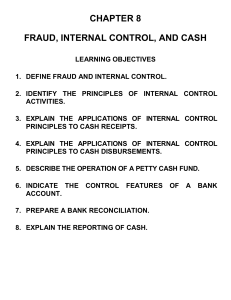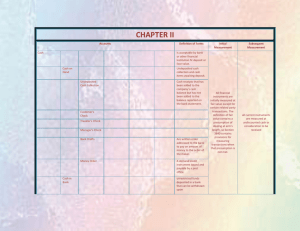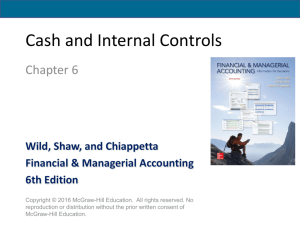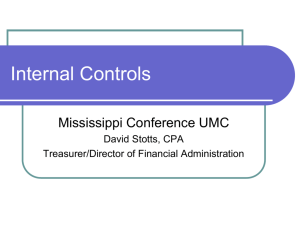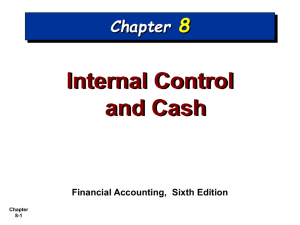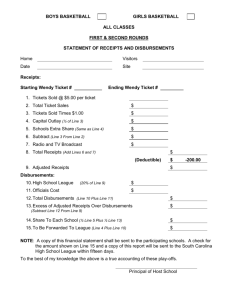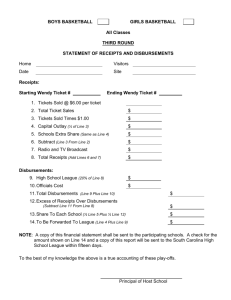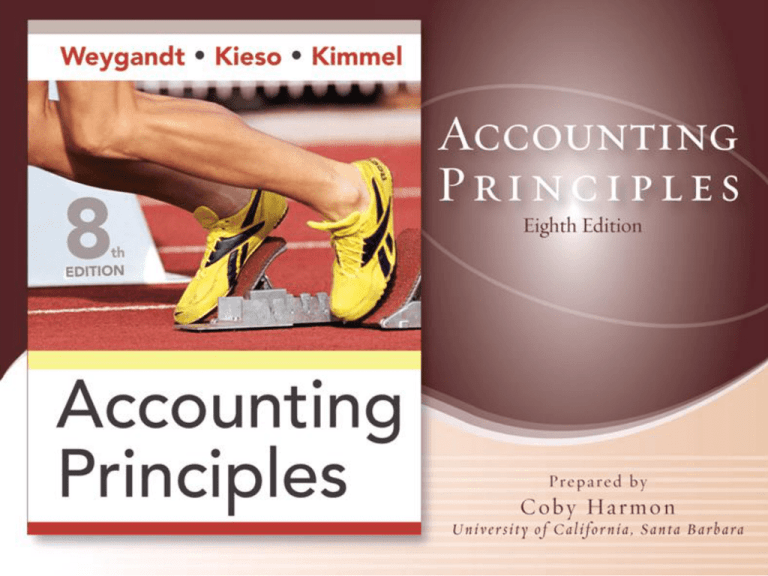
Chapter
8-1
CHAPTER 8
INTERNAL
CONTROL
AND CASH
Accounting Principles, Eighth Edition
Chapter
8-2
Study Objectives
1.
Define internal control.
2. Identify the principles of internal control.
3. Explain the applications of internal control principles
to cash receipts.
4. Explain the applications of internal control principles
to cash disbursements.
5. Describe the operation of a petty cash fund.
6. Indicate the control features of a bank account.
7. Prepare a bank reconciliation.
8. Explain the reporting of cash.
Chapter
8-3
Internal Control and Cash
Internal
Control
Cash
Controls
Use of a Bank
Reporting
Cash
The SarbanesOxley Act
Control over
cash receipts
Making
deposits
Cash
equivalents
Principles
Limitations
Control over
cash
disbursements
Writing checks
Bank
statements
Reconciling the
bank account
Restricted
cash
Compensating
balances
Chapter
8-4
Internal Control
Methods and measures adopted to:
1. Safeguard assets.
2. Enhance accuracy and reliability of accounting
records. Reduce risk of:
a. Errors (unintentional)
b. Irregularities (intentional)
Under the Sarbanes-Oxley Act, all publicly traded U.S. corporations
are required to maintain an adequate system of internal control.
Chapter
8-5
LO 1 Define internal control.
Internal Control
The Sarbanes-Oxley Act
Companies must
develop principles of control over financial
reporting.
continually verify that controls are working.
Independent auditors must attest to the level of
internal control.
SOX created the Public Company Accounting
Oversight Board (PCAOB).
Chapter
8-6
LO 1 Define internal control.
Internal Control
Principles of Internal Control
Illustration 8-1
Measures vary with
size and nature of
the business.
management’s control
philosophy.
Chapter
8-7
LO 2 Identify the principles of internal control.
Internal Control
Principles of Internal Control
ESTABLISHMENT OF RESPONSIBILITY
Control is most effective when only one person is responsible
for a given task.
SEGREGATON OF DUTIES
Related duties, including physical custody and record
keeping, should be assigned to different individuals.
DOCUMENTATION PROCEDURES
Companies should use prenumbered documents for all
documents should be accounted for.
Chapter
8-8
LO 2 Identify the principles of internal control.
Internal Control
Principles of Internal Control
Illustration 8-3
PHYSICAL, MECHANICAL, AND ELECTRONIC CONTROLS
Physical
Mechanical
and
Electronic
Chapter
8-9
LO 2 Identify the principles of internal control.
Internal Control
Principles of Internal Control
INDEPENDENT INTERNAL VERIFICATION
1. Records periodically verified by an employee who is
independent.
2. Discrepancies reported to management.
OTHER CONTROLS
1. Bond employees.
2. Rotate employees’ duties and require vacations.
3. Conduct background checks.
Chapter
8-10
LO 2 Identify the principles of internal control.
Internal Control
Limitations of Internal Control
Costs should not exceed benefit.
Human element.
Size of the business.
Chapter
8-11
LO 2 Identify the principles of internal control.
Cash Controls
Internal Control over Cash Receipts
Establishment of
Responsibility
Only designated
personnel are
authorized to handle
cash receipts
(cashiers)
Documentation
Procedures
Use remittance
advice (mail
receipts), cash
register tapes, and
deposit slips
Independent Internal
Verification
Supervisors count cash
receipts daily;
treasurer compares
total receipts to bank
deposits daily
Segregation of Duties
Different individuals
receive cash, record
cash receipts, and hold
the cash
Physical,
Mechanical, and
Electronic Controls
Other Controls
Bond personnel who
handle cash; require
employees to take
vacations; deposit all
cash in bank daily
Illustration 8-5
Chapter
8-12
Store cash in safes
and bank vaults; limit
access to storage
areas; use cash
registers
LO 3 Explain the applications of internal control principles to cash receipts.
Cash Controls
Discussion Question
Q8-3. At the corner grocery store, all sales
clerks make change out of one cash register
drawer. Is this a violation of internal control?
Why?
See notes page for discussion
Chapter
8-13
LO 3 Explain the applications of internal control principles to cash receipts.
Cash Controls
Cash consists of coins, currency, checks, money
orders, and money on hand or on deposit in a bank.
Cash receipts come from:
cash sales
collections on account from customers
receipt of interest, rent, and dividends
investments by owners
bank loans
proceeds from the sale of noncurrent assets
Chapter
8-14
LO 3 Explain the applications of internal control principles to cash receipts.
Cash Controls
Discussion Question
Q8-8. The management of Sewell Company asks
you, as the company accountant, to explain (a)
the concept of reasonable assurance in internal
control and (b) the importance of the human
factor in internal control.
See notes page for discussion
Chapter
8-15
LO 3 Explain the applications of internal control principles to cash receipts.
Cashier’s Department
Over-the-Counter Receipts
Sales Department
Illustration 8-7
Prepare daily summary
Prepare deposit slip
Cashier ring up sales
Supervisor
1. reads register totals
2. makes cash counts
3. prepares cash count
sheets
Chapter
8-16
Bank
(deposit)
Treasurer Accounting
(verification)
(record)
LO 3 Explain the applications of internal control principles to cash receipts.
Mail Receipts
Control Procedures:
Mail receipts should be opened by two people, a
list prepared, and each check endorsed.
Copy of the list, along with the checks and
remittance advices, sent to cashier’s department.
Cashier adds the checks to the over-the-counter
receipts and prepares a daily cash summary and
makes the daily bank deposit.
Copy of list sent to treasurer’s office for
comparison with total shown on daily cash
summary.
Chapter
8-17
LO 3 Explain the applications of internal control principles to cash receipts.
Cash Controls
Review Question
Permitting only designated personnel to handle
cash receipts
is an application of the principle of:
a. segregation of duties.
b. establishment of responsibility.
c. independent check.
d. other controls.
Chapter
8-18
LO 3 Explain the applications of internal control principles to cash receipts.
Cash Controls
Internal Control over Cash Disbursements
Generally, internal control over cash
disbursements is more effective when
companies pay by check, rather than by cash.
Applications:
Voucher system
Electronic funds transfers (EFT) system
Petty cash fund
Chapter
8-19
LO 4 Explain the applications of internal control
principles to cash disbursements.
Cash Controls
Internal Control over Cash Disbursements
Establishment of
Responsibility
Only designated
personnel are
authorized to sign
checks (treasurer)
Segregation of Duties
Different individuals
approve and make
payments; check
signers do not record
disbursements
Documentation
Procedures
Use prenumbered
checks and account
for them in
sequence; each check
must have an
approved invoice
Other Controls
Stamp invoices
PAID
Independent Internal
Verification
Compare checks to
invoices; reconcile bank
statement monthly
Physical, Mechanical,
and Electronic
Controls
Store blank checks in
safes, with limited
access; print check
amounts by machine in
indelible ink
Illustration 8-8
Chapter
8-20
LO 4 Explain the applications of internal control
principles to cash disbursements.
Cash Controls
Discussion Question
Q8-14. Joe Griswold Company’s internal
controls over cash disbursements provide for
the treasurer to sign checks imprinted by a
checkwriting machine in indelible ink after
comparing the check with the approved invoice.
Identify the internal control principles that are
present in these controls.
See notes page for discussion
Chapter
8-21
LO 4 Explain the applications of internal control
principles to cash disbursements.
Cash Controls
Review Question
The use of prenumbered checks in disbursing
cash is an application of the principle of:
a. establishment of responsibility.
b. segregation of duties.
c. physical, mechanical, and electronic controls.
d. documentation procedures.
Chapter
8-22
LO 4 Explain the applications of internal control
principles to cash disbursements.
Cash Controls
Internal Control over Cash Disbursements
Voucher System
Network of approvals, by authorized
individuals, to ensure all disbursements by
check are proper.
A voucher is an authorization form prepared
for each expenditure.
Chapter
8-23
LO 4 Explain the applications of internal control
principles to cash disbursements.
Cash Controls
Internal Control over Cash Disbursements
Electronic Funds Transfers (EFT)
Disbursement systems that uses wire,
telephone, or computers to transfer cash
balances between locations.
Chapter
8-24
LO 4 Explain the applications of internal control
principles to cash disbursements.
Cash Controls
Internal Control over Cash Disbursements
Petty Cash Fund - Used to pay small amounts.
Involves:
1. establishing the fund,
2. making payments from the fund, and
3. replenishing the fund.
Chapter
8-25
LO 5 Describe the operation of a petty cash fund.
Cash Controls
E8-8 Lincolnville Company uses an imprest petty cash system. The
fund was established on March 1 with a balance of $100. During
March the following petty cash receipts were found in the petty cash
box.
March 5
Stamp inventory
March 7
Freight-out
March 9
Miscellaneous expense
March 11
Travel expense
March 14
Miscellaneous expense
$39
21
6
24
5
The fund was replenished on March 15 when the fund contained $3 in
cash. On March 20, the amount in the fund was increased to $150.
Instructions: Journalize the entries in March that pertain to the
operation of the petty cash fund.
Chapter
8-26
LO 5 Describe the operation of a petty cash fund.
Cash Controls
E8-8 The fund was established on March 1 with a
balance of $100.
March 1
Chapter
8-27
Petty cash
Cash
100
100
LO 5 Describe the operation of a petty cash fund.
Cash Controls
E8-8 The fund was replenished on March 15 when the
fund contained $3 in cash.
March 15
Postage expense
Freight-out
39
21
Miscellaneous expense
Travel expense
Cash over and short
11
24
2
Cash
Chapter
8-28
97
LO 5 Describe the operation of a petty cash fund.
Cash Controls
E8-8 On March 20, the amount in the fund was
increased to $150.
March 20
Chapter
8-29
Petty cash
Cash
50
50
LO 5 Describe the operation of a petty cash fund.
Use of a Bank
Contributes to good internal control over cash.
Minimizes the amount of currency on hand.
Creates a double record of bank transactions.
Bank reconciliation.
Chapter
8-30
LO 6 Indicate the control features of a bank account.
Use of a Bank
Making Bank Deposits
Authorized employee
should make deposit.
Front Side
Chapter
8-31
Illustration 8-10
Bank Code
Numbers
Reverse Side
LO 6 Indicate the control features of a bank account.
Use of a Bank
Writing Checks
Illustration 8-11
Written order signed by depositor directing bank to pay
a specified sum of money to a designated recipient.
Maker
Payee
Payer
Chapter
8-32
LO 6 Indicate the control features of a bank account.
Use of a Bank
Bank Statements
Illustration 8-12
Debit Memorandum
Bank service charge
NSF (not sufficient
funds)
Credit Memorandum
Collect notes
receivable.
Interest earned.
Chapter
8-33
LO 6 Indicate the control features of a bank account.
Use of a Bank
Review Question
The control features of a bank account do not
include:
a. having bank auditors verify the correctness of
the bank balance per books.
b. minimizing the amount of cash that must be kept
on hand.
c. providing a double record of all bank
transactions.
d. safeguarding cash by using a bank as a
depository.
Chapter
8-34
LO 6 Indicate the control features of a bank account.
Use of a Bank
Reconciling the Bank Account
Reconcile balance per books and balance per bank to
their adjusted (corrected) cash balances.
Reconciling Items:
1. Deposits in transit.
2. Outstanding checks.
3. Errors.
4. Bank memoranda.
Chapter
8-35
LO 7 Prepare a bank reconciliation.
Use of a Bank
Reconciliation Procedures
Illustration 8-13
+ Deposit in Transit
+ Notes collected by bank
-
-
NSF (bounced) checks
-
Check printing or other
service charges
Outstanding Checks
+- Bank Errors
+- Book Errors
CORRECT BALANCE
Chapter
8-36
CORRECT BALANCE
LO 7 Prepare a bank reconciliation.
Use of a Bank
E8-11 The following information pertains to Family Video Company.
1.
Cash balance per bank, July 31, $7,263.
2.
Cash balance per books, July 31, $7,284.
3.
July bank service charge not recorded by the depositor $28.
4.
Deposits in transit, July 31, $1,500.
5.
Bank collected $900 note for Family in July, plus interest $36,
less fee $20.The collection has not been recorded by Family, and
no interest has been accrued.
6.
Outstanding checks, July 31, $591.
Instructions
a) Prepare a bank reconciliation at July 31.
b) Journalize the adjusting entries at July 31 on the books of Family
Video Company.
Chapter
8-37
LO 7 Prepare a bank reconciliation.
Use of a Bank
E8-11 a) Prepare a bank reconciliation at July 31.
Cash balance per bank statement
Add:
Deposit in transit
Less:
Outstanding checks
Adjusted cash balance per bank
Cash balance per books
Add:
Collection of notes receivable
Collection of interest
Less:
Bank service charge
Note collection fee
Adjusted cash balance per books
Chapter
8-38
$7,263
1,500
(591)
$8,172
$7,284
900
36
(28)
(20)
$8,172
LO 7 Prepare a bank reconciliation.
Use of a Bank
E8-11 b) Journalize the adjusting entries at July 31 on
the books of Family Video Company.
Dr.
Cr.
July 31
Miscellaneous expense
28
July 31
Cash
Cash
916
Miscellaneous expense
Interest revenue
Notes receivable
28
20
36
900
Note: Adjusting journal entry includes only the
adjustments to the cash balance per books.
Chapter
8-39
LO 7 Prepare a bank reconciliation.
Use of a Bank
Review Question
The reconciling item in a bank reconciliation that
will result in an adjusting entry by the depositor
is:
a. outstanding checks.
b. deposit in transit.
c. a bank error.
d. bank service charges.
Chapter
8-40
LO 7 Prepare a bank reconciliation.
Use of a Bank
Review Question
Which of the following statements correctly
describes the reporting of cash?
a. Cash cannot be combined with cash equivalents.
b. Restricted cash funds may be combined with
Cash.
c. Cash is listed first in the current assets
section.
d. Restricted cash funds cannot be reported as a
current asset.
Chapter
8-41
LO 7 Prepare a bank reconciliation.
Recording Process
Discussion Question
Q8-20. Lori Figgs is confused about the lack of
agreement between the cash balance per books and the
balance per the bank. Explain the causes for the lack of
agreement to Lori, and give an example of each cause.
See notes page for discussion
Chapter
8-42
LO 7 Prepare a bank reconciliation.
Reporting Cash
Most liquid asset, listed first in current assets
section of balance sheet.
Illustration 8-16
Cash equivalents
Restricted cash
Compensating balances
Chapter
8-43
LO 8 Explain the reporting of cash.
Copyright
“Copyright © 2008 John Wiley & Sons, Inc. All rights reserved.
Reproduction or translation of this work beyond that permitted
in Section 117 of the 1976 United States Copyright Act without
the express written permission of the copyright owner is
unlawful. Request for further information should be addressed
to the Permissions Department, John Wiley & Sons, Inc. The
purchaser may make back-up copies for his/her own use only
and not for distribution or resale. The Publisher assumes no
responsibility for errors, omissions, or damages, caused by the
use of these programs or from the use of the information
contained herein.”
Chapter
8-44


